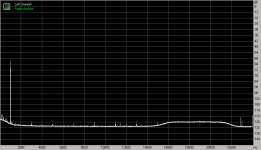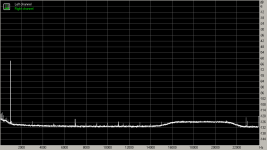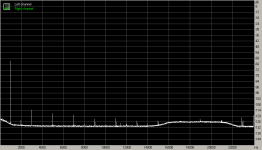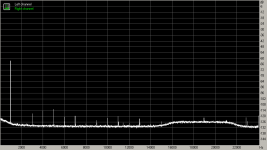All chips are different, Two Ks will never look the same. One K may be good, another one bad. And a J may be better than a K.
And it is only a very little invisible matter of implementation.
Paul,
swap the chips and you will see it is the chips and not the DAC channels.
I am short of time another comments later...
And it is only a very little invisible matter of implementation.
Paul,
swap the chips and you will see it is the chips and not the DAC channels.
I am short of time another comments later...
So where does that leave us?
It seems the only reasonable path is to buy a quantity of chips and then select sets.
It seems the only reasonable path is to buy a quantity of chips and then select sets.
Selecting the PCMs
Indeed. May I quote here my p.s., as posted once on the PCM63P-Y ??? thread (Post #19 ):
"p.s. To get the maximum results from the PCMs (before any tweaking...) may be you should even consider selecting/dividing them into 2 perfect matching (sounding) pairs."
I did exactly this, even if "only" by listening. The differences between the chips have been very big!!
Greetings,
IY
spzzzzkt said:So where does that leave us?
It seems the only reasonable path is to buy a quantity of chips and then select sets.
Indeed. May I quote here my p.s., as posted once on the PCM63P-Y ??? thread (Post #19 ):
"p.s. To get the maximum results from the PCMs (before any tweaking...) may be you should even consider selecting/dividing them into 2 perfect matching (sounding) pairs."
I did exactly this, even if "only" by listening. The differences between the chips have been very big!!
Greetings,
IY
Bernhard said:All chips are different, Two Ks will never look the same. One K may be good, another one bad. And a J may be better than a K.
Bernhard,
The question is if we can agree that if once perfectly selected, a matched pair of "Y" will outperform a matched pair of "K", "K" will outperform "J", etc.
If very good chips are selected out of batches of Ks, Js, Ys, the only thing that does matter is the test result.
Stamps are totally unimportant.
My selected lot of PCM56 contains everything from L , plain, J, K, K° and S.
Also, even if those Y are no fakes and even if the stamp means someting about quality, I don't believe it because it is known that molding in plastic does harm to the accuracy, which means producing to meet specs is nonsens. Those have no after production stamps, so those are not selected 99%. Also I believe the chips become stable only after burn in, so I only use chips from players, never new ones.
Stamps are totally unimportant.
My selected lot of PCM56 contains everything from L , plain, J, K, K° and S.
Also, even if those Y are no fakes and even if the stamp means someting about quality, I don't believe it because it is known that molding in plastic does harm to the accuracy, which means producing to meet specs is nonsens. Those have no after production stamps, so those are not selected 99%. Also I believe the chips become stable only after burn in, so I only use chips from players, never new ones.
Re: Selecting the PCMs
Did you match the Ys ? How many chips did you have ?
So you say it yourself, the stamp or Y does not mean anything...
George found the no grades from Rotel are better than some Ks.
Or Paul, left and right, one good, the other one garbage.
spzzzzkt found left and right to be very different.
It is just like that. Accept it. Same with Philips crowns.
My selected PCM56 chips are in the range from -64 to -66 dB relative = -124 to -126 dB absolute for worst harmonic.
But that degrades to -60/-120 dB for non os. Still good enough.
I will compare 1k and 997 Hz.
irgendjemand said:
you should even consider selecting/dividing them into 2 perfect matching (sounding) pairs."
I did exactly this, even if "only" by listening. The differences between the chips have been very big!!
Did you match the Ys ? How many chips did you have ?
So you say it yourself, the stamp or Y does not mean anything...
George found the no grades from Rotel are better than some Ks.
Or Paul, left and right, one good, the other one garbage.
spzzzzkt found left and right to be very different.
It is just like that. Accept it. Same with Philips crowns.
My selected PCM56 chips are in the range from -64 to -66 dB relative = -124 to -126 dB absolute for worst harmonic.
But that degrades to -60/-120 dB for non os. Still good enough.
I will compare 1k and 997 Hz.
Joseph K said:This the Rotel, with PCM63P - no stamp, -60dB NoiseShaped 1kHz signal
What is the exact level of the fundamental 1k in the spectrum of this and other posts ? -60 or -65 ? Looks a little like it is cut in the graph.
Is it with averaging ?
Bernhard,
I had 4 Picks of "Y" at first, until I found one real match. The other 2 Picks have not been so good. I send them back.
Then, to be very precise: I bought one Pair of "K" as a matched-pair (and it was absolutely OK); the other pair I selected from 6 Picks, where I can say that I got also a second "OK" pair (from the same bunch) and 2 quite useless PCMs as well.
However, by comparing the best "Y" to the best "K", I personally had no doubt that the "Y" was the better one. This "Y-match" sounds better then any of the other 3 “K” pairs.
I shell give you the "Y" to try & measure. My only problem is that they are mounted directly on the PCB, and I don't find time to take them apart. May be, we should do this once I am in Munich. I will bring the DAC, you will take them apart…. then we will listen.
I am open to learn, every day new and I have a lot of respect to your immense knowledge.
I had 4 Picks of "Y" at first, until I found one real match. The other 2 Picks have not been so good. I send them back.
Then, to be very precise: I bought one Pair of "K" as a matched-pair (and it was absolutely OK); the other pair I selected from 6 Picks, where I can say that I got also a second "OK" pair (from the same bunch) and 2 quite useless PCMs as well.
However, by comparing the best "Y" to the best "K", I personally had no doubt that the "Y" was the better one. This "Y-match" sounds better then any of the other 3 “K” pairs.
I shell give you the "Y" to try & measure. My only problem is that they are mounted directly on the PCB, and I don't find time to take them apart. May be, we should do this once I am in Munich. I will bring the DAC, you will take them apart…. then we will listen.
I am open to learn, every day new and I have a lot of respect to your immense knowledge.
Hi guys,
I am the actual owner of the chips that beauty-divine is testing. I must say that there is a difference in sound and it is obvious between the Y and K grade but there was also difference between the k grades too. So it is up to you to decide whether you like or not the sound of the Y grade, may be in some systems it fits perfect and in others it just does not sound good. It is definitely a PCM 63 chip, otherwise it would not work. The test so far show that it is up to at least the K grade, I did not have time to talk to B_D but he mentioned that he is still measuring them. My personal impression is that the two chips are consistent in sound, whether you like it or not is up to you. Rare chips for sure...
I am the actual owner of the chips that beauty-divine is testing. I must say that there is a difference in sound and it is obvious between the Y and K grade but there was also difference between the k grades too. So it is up to you to decide whether you like or not the sound of the Y grade, may be in some systems it fits perfect and in others it just does not sound good. It is definitely a PCM 63 chip, otherwise it would not work. The test so far show that it is up to at least the K grade, I did not have time to talk to B_D but he mentioned that he is still measuring them. My personal impression is that the two chips are consistent in sound, whether you like it or not is up to you. Rare chips for sure...
IY, fishzug,
sounds like the performance potential is there but the "grading" is no guarantee even with BB chips.
I've reached a position where I feel that I would be happy with the "forged" chips providing I can get a set of 4 that perform to a similar level of the chips in the left channel. it seems like there are more cost effective ways to get good chips, but if i end up with a good set I'll be happy. looks like I might have to try to get hold of a few more chips for testing.
bernhard, do you think it's sufficient to test the chips at 991/1khz to profile the performance? or should i perform other tests?
cheers
Paul
sounds like the performance potential is there but the "grading" is no guarantee even with BB chips.
I've reached a position where I feel that I would be happy with the "forged" chips providing I can get a set of 4 that perform to a similar level of the chips in the left channel. it seems like there are more cost effective ways to get good chips, but if i end up with a good set I'll be happy. looks like I might have to try to get hold of a few more chips for testing.
bernhard, do you think it's sufficient to test the chips at 991/1khz to profile the performance? or should i perform other tests?
cheers
Paul
i have about 22 pc's supposed to be NOS.
As well all have D1V3's we should use that as a test platform and maybe some swapping should take place here and there what do you think 🙂
also what about digital filters? I think I get 42APT
As well all have D1V3's we should use that as a test platform and maybe some swapping should take place here and there what do you think 🙂
also what about digital filters? I think I get 42APT
That could be a solution although I'd assume everybody would want to get the best performing set 😉 I'd like to see if I can arrange something with A'af so I can get a better matched set of the Y's. If I can get both channels matching the current results from the left channel performance should be quite respectable.
I'm planning to pick up a 28pin ZIF socket and fabricate an adapter before I embark on anymore chip swapping to avoid mangling pins and sockets.
Reading Julian Dunn's "Application Note 5: Measurement Techniques for Digital Audio" which can be downloaded from http://ap.com/library/technotes.htm I note that AP use a dithered -60dB 997hz test tone. This might be a good standard for testing?
cheers
Paul
I'm planning to pick up a 28pin ZIF socket and fabricate an adapter before I embark on anymore chip swapping to avoid mangling pins and sockets.
Reading Julian Dunn's "Application Note 5: Measurement Techniques for Digital Audio" which can be downloaded from http://ap.com/library/technotes.htm I note that AP use a dithered -60dB 997hz test tone. This might be a good standard for testing?
cheers
Paul
D1 Owners manual:
So Pass Labs was not trusting the manufacturers grading to provide adequately matched chips.
I'd also point out that the Dunn app note mentions that the noise floors need to be adjusted to account for the FFT windowing - and this could boost the noise floor by around 15dB or more - so please don't take the RMAA graph as an accurate indicator of absolute performance. I'd only be confident to make relative comparison of chips tested in the same environment.
The D/A Converters are selected for matched characteristic to minimize distortion and noise.
So Pass Labs was not trusting the manufacturers grading to provide adequately matched chips.
I'd also point out that the Dunn app note mentions that the noise floors need to be adjusted to account for the FFT windowing - and this could boost the noise floor by around 15dB or more - so please don't take the RMAA graph as an accurate indicator of absolute performance. I'd only be confident to make relative comparison of chips tested in the same environment.
The situation really reminds me of tubes - I first check parameters (i.e. select the grade) and then match them in pairs by sound. Grading always comes first though, I don't like snake oil and I never let chance determine what happens in the end...
I've checked all the pcm63's I have: both the "military grade pcm63k" ($25ea) and "ultra rare pcm63p-y" ($60ea) bought from A'af. From what I can see the best of the Y's is slightly better terms of harmonics that the best 63k. The worst of the Y's is on a par with the worst 63K.
Attached is the best Y
Attached is the best Y
Attachments
And this is the best of the "junker" PCM63K.
The noise floor seems more "jaggy" than the Y but the measurements were taken in the morning vs at night so there is possibly more rf junk. I also forgot to switch off the wifi base station so that could be contributing low level hash.
The noise floor seems more "jaggy" than the Y but the measurements were taken in the morning vs at night so there is possibly more rf junk. I also forgot to switch off the wifi base station so that could be contributing low level hash.
Attachments
- Status
- Not open for further replies.
- Home
- Source & Line
- Digital Line Level
- Real or fake PCM63?



